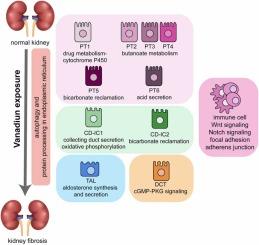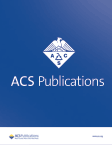单核 RNA 测序揭示鸭肾细胞和分子对钒暴露的反应
IF 2.9
Q2 PUBLIC, ENVIRONMENTAL & OCCUPATIONAL HEALTH
引用次数: 0
摘要
已知钒(V)暴露会诱发肾毒性,但其对肾细胞类型和分子机制的具体影响仍不完全清楚。我们利用单核 RNA 测序(snRNA-seq)从细胞分辨率上描述了钒对鸭肾细胞的影响。暴露 44 天后,免疫荧光分析显示肾间质中 α-SMC 的表达显著增加,表明存在纤维化反应。SnRNA-seq鉴定出了肾脏内分为19个细胞簇的12种主要细胞类型。观察到细胞组成发生了显著变化,特别是近端小管细胞(PT2亚型)、肾小球内皮细胞、主细胞增加,免疫细胞比例发生变化,而集合管夹层细胞(CD-IC)和粗升肢细胞百分比下降。差异基因表达分析强调了不同细胞类型中与 V 毒性有关的通路。PT细胞在药物代谢-细胞色素P450、丁酸代谢和肌动蛋白细胞骨架调节方面发生了变化。CD-IC细胞的集合管分泌、氧化磷酸化和碳酸氢盐回收途径发生了变化。此外,免疫细胞显示出 T 细胞受体和趋化因子信号通路的变化,表明免疫反应发生了改变。总之,这些发现有助于更好地揭示V诱导的肾损伤的致病机制。本文章由计算机程序翻译,如有差异,请以英文原文为准。

Single Nucleus RNA Sequencing Reveals Cellular and Molecular Responses to Vanadium Exposure in Duck Kidneys
Vanadium (V) exposure is known to induce renal toxicity, yet its specific effects on renal cell types and molecular mechanisms remain incompletely understood. We used single nucleus RNA sequencing (snRNA-seq) to characterize the impact of V on duck kidney cells at a cellular resolution. Following a 44-day exposure, immunofluorescence analysis revealed a significant increase in α-SMC expression in the renal interstitium, indicative of fibrotic response. SnRNA-seq identified 12 major cell types organized into 19 clusters within the kidney. Significant changes in cell composition were observed, notably an increase in proximal tubule cells (PT2 subtype), glomerular endothelial cells, principal cells, and alterations in immune cell proportions, while collecting duct intercalated cells (CD-IC) and thick ascending limb showed decreased percentages. Differential gene expression analysis highlighted pathways implicated in V toxicity across different cell types. Changes in drug metabolism-cytochrome P450, butanoate metabolism, and actin cytoskeleton regulation were exhibited by PT cells. Alterations in collecting duct secretion, oxidative phosphorylation, and bicarbonate reclamation pathways were shown in CD-IC cells. Furthermore, immune cells displayed changes in T cell receptor and chemokine signaling pathways, indicative of altered immune responses. Taken together, these findings contribute to a better shedding light on the pathogenic mechanisms of V induced renal injury.
求助全文
通过发布文献求助,成功后即可免费获取论文全文。
去求助
来源期刊

ACS Chemical Health & Safety
PUBLIC, ENVIRONMENTAL & OCCUPATIONAL HEALTH-
CiteScore
3.10
自引率
20.00%
发文量
63
期刊介绍:
The Journal of Chemical Health and Safety focuses on news, information, and ideas relating to issues and advances in chemical health and safety. The Journal of Chemical Health and Safety covers up-to-the minute, in-depth views of safety issues ranging from OSHA and EPA regulations to the safe handling of hazardous waste, from the latest innovations in effective chemical hygiene practices to the courts'' most recent rulings on safety-related lawsuits. The Journal of Chemical Health and Safety presents real-world information that health, safety and environmental professionals and others responsible for the safety of their workplaces can put to use right away, identifying potential and developing safety concerns before they do real harm.
 求助内容:
求助内容: 应助结果提醒方式:
应助结果提醒方式:


